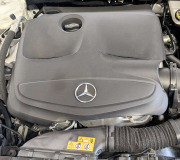Low oil pressure in an engine regardless of mileage is often an indication that something is seriously wrong and requires immediate attention.
The oil pump itself does not create pressure. It produces flow and the resistance to that flow produces pressure. Resistance is created by the orifices in the engine block through which the oil flows, and the amount of clearance between the bearings and crankshaft journals. As the bearings wear, clearances increase allowing increased flow which reduces pressure.
A good place to start your diagnosis of a low oil pressure condition is at the dipstick. Check the oil level to see that it is at the proper level (not low and not overfilled)
Recheck the pump for proper installation,
If the pump appears to be okay, the next step would be to measure the rod and main bearing clearances. Check the clearances on the main bearing closest the pump (since this has the greatest effect on pressure), and clearances on the furthest rod bearing (since this will show the greatest wear). If the bearings are worn, they need to be replaced. But before you do so, carefully inspect and measure the crankshaft journals to check for wear, scoring, out-of-round and taper. If the journals need attention, the crank will also have to be reground or replaced.
SPONSORED LINKS
Wednesday, November 18th, 2009 AT 10:54 AM




